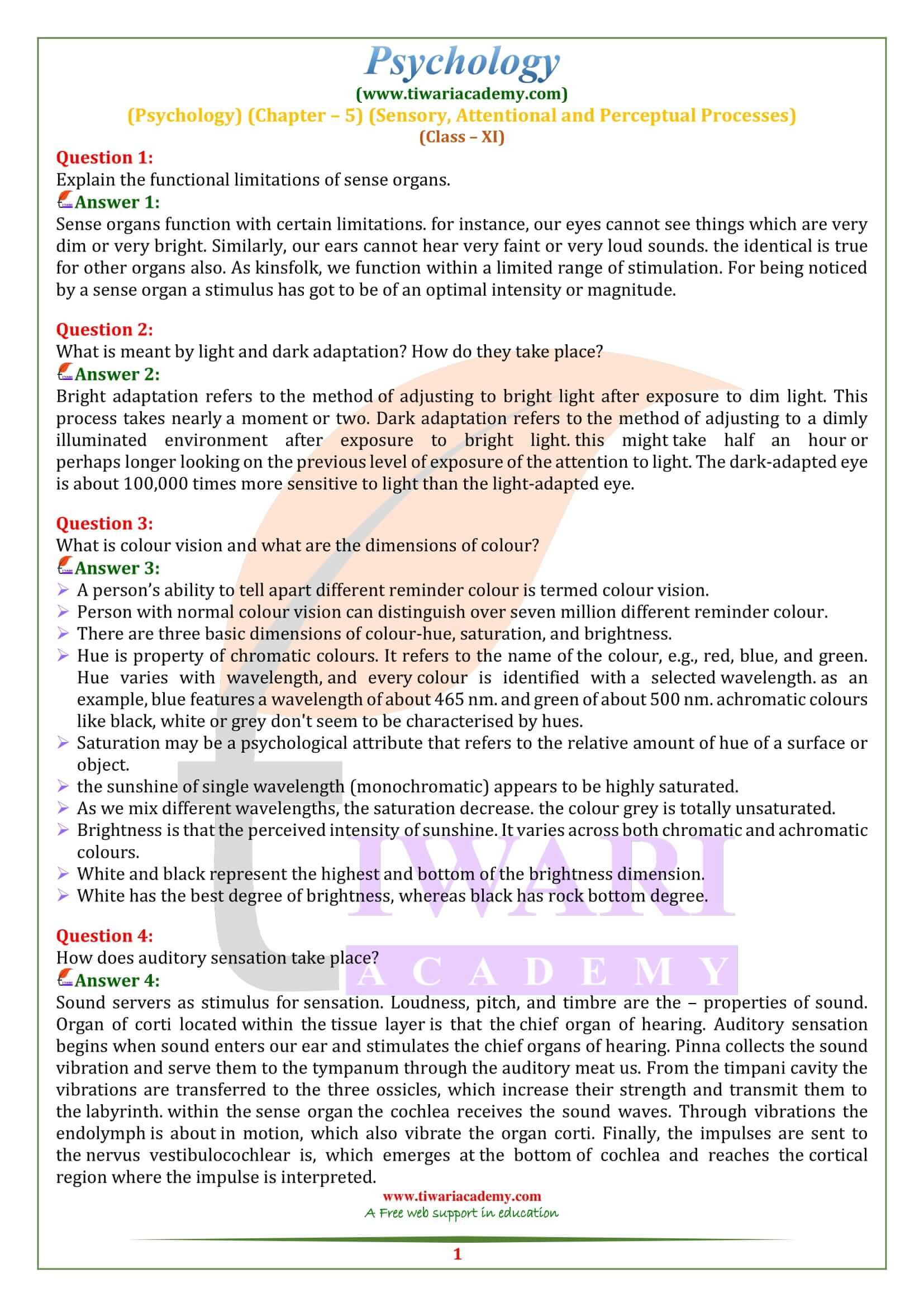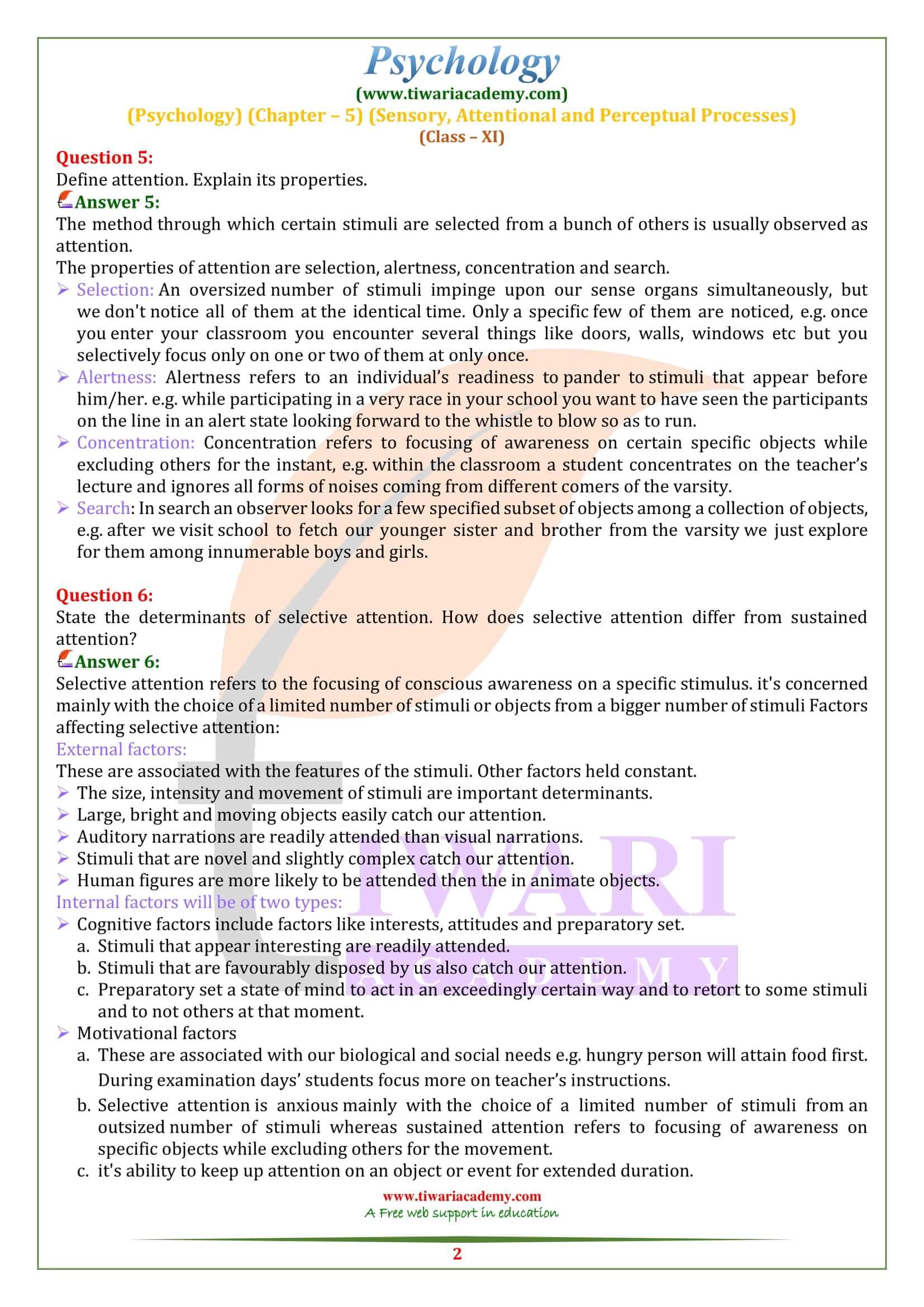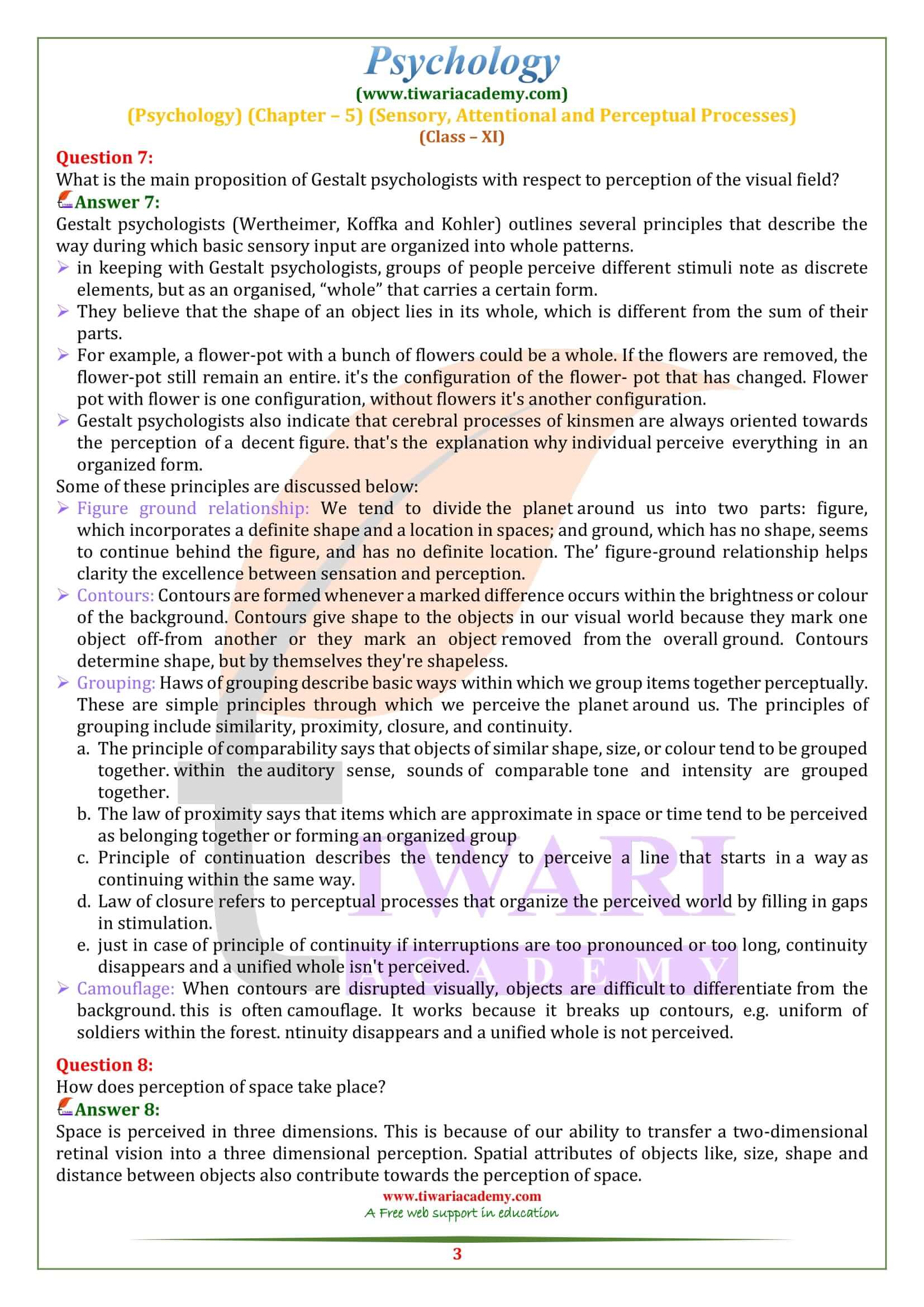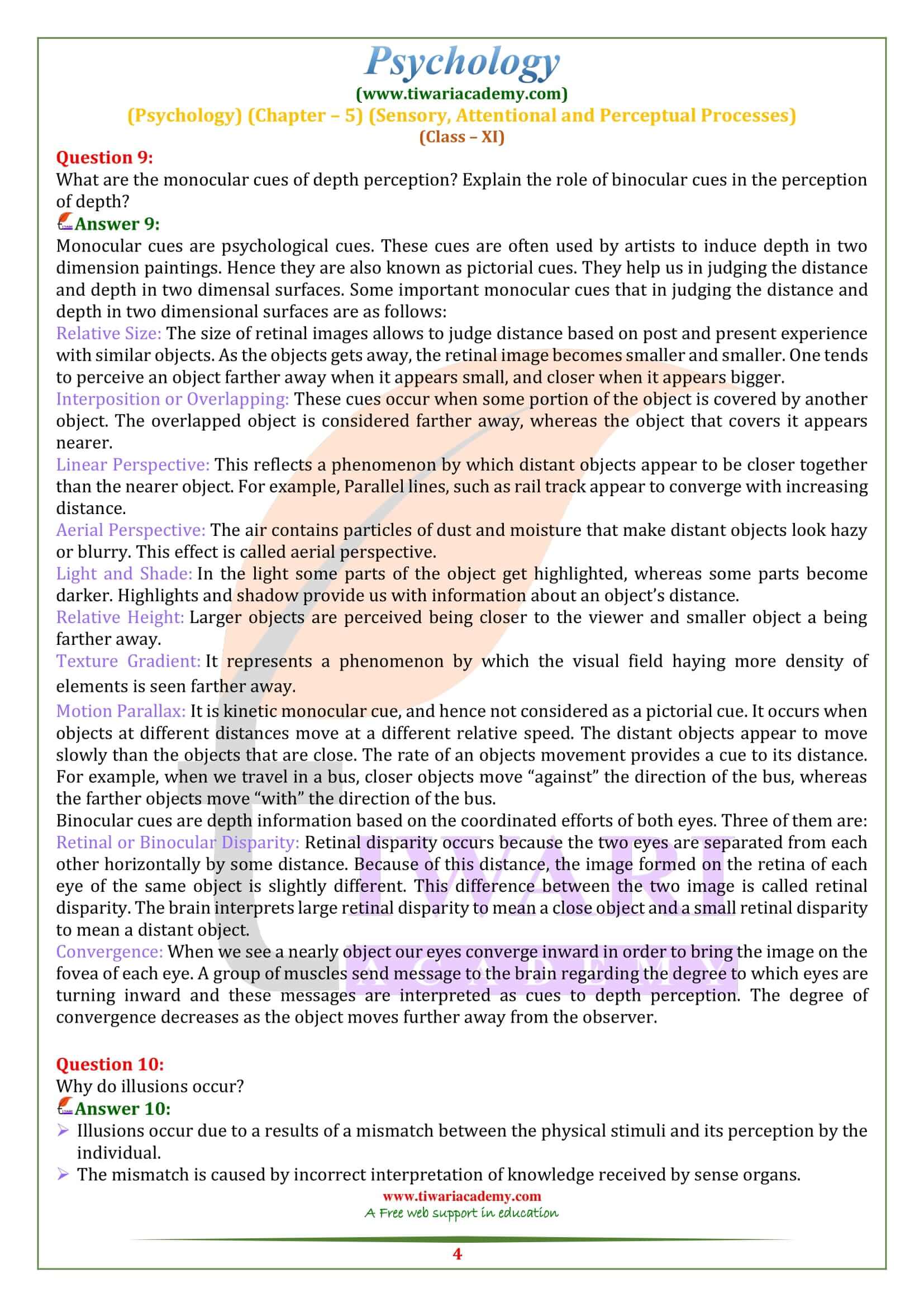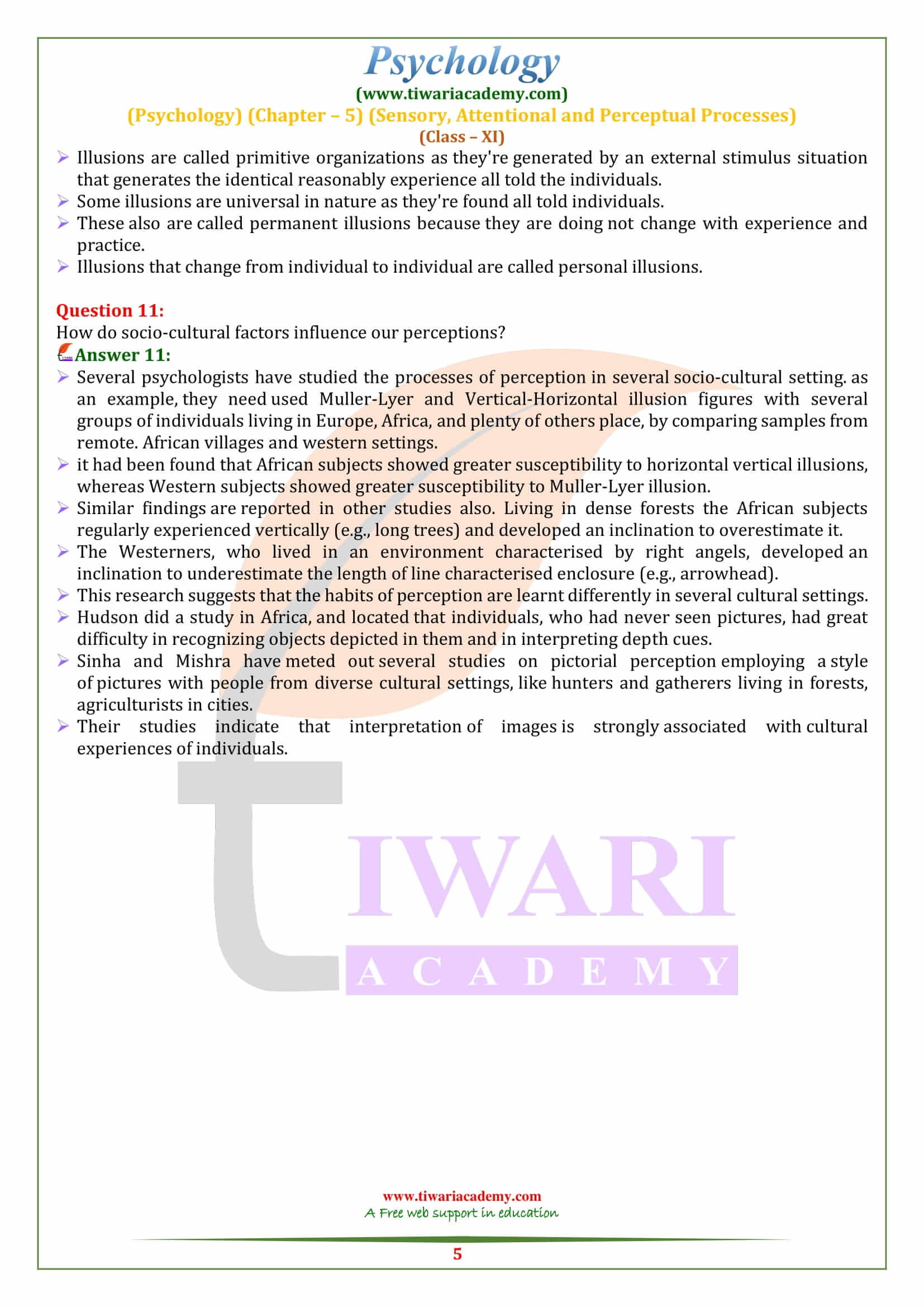NCERT Solutions for Class 11 Psychology Chapter 5 Sensory, Attentional and Perceptual Processes updated for CBSE and state board students. Important Questions and MCQ for session 2025-26 given here will also help the students to be confident in final exams. Exercises Question Answers are explained in simple manner.
NCERT Solutions for Class 11 Psychology Chapter 5
Class 11 Psychology Chapter 5 Sensory, Attentional and Perceptual Processes Quesiton Answers
Explain the functional limitations of sense organs.
Sense organs function with certain limitations. for instance, our eyes cannot see things which are very dim or very bright. Similarly, our ears cannot hear very faint or very loud sounds. the identical is true for other organs also. As kinsfolk, we function within a limited range of stimulation. For being noticed by a sense organ a stimulus has got to be of an optimal intensity or magnitude.
What is colour vision and what are the dimensions of colour?
- A person’s ability to tell apart different reminder colour is termed colour vision.
- Person with normal colour vision can distinguish over seven million different reminder colour.
- There are three basic dimensions of colour-hue, saturation, and brightness.
- Hue is property of chromatic colours. It refers to the name of the colour, e.g., red, blue, and green. Hue varies with wavelength, and every colour is identified with a selected wavelength. as an example, blue features a wavelength of about 465 nm. and green of about 500 nm. achromatic colours like black, white or grey don’t seem to be characterised by hues.
- Saturation may be a psychological attribute that refers to the relative amount of hue of a surface or object.
- The sunshine of single wavelength (monochromatic) appears to be highly saturated.
- As we mix different wavelengths, the saturation decrease. the colour grey is totally unsaturated.
- Brightness is that the perceived intensity of sunshine. It varies across both chromatic and achromatic colours.
- White and black represent the highest and bottom of the brightness dimension.
- White has the best degree of brightness, whereas black has rock bottom degree.
What is meant by light and dark adaptation? How do they take place?
Bright adaptation refers to the method of adjusting to bright light after exposure to dim light. This process takes nearly a moment or two. Dark adaptation refers to the method of adjusting to a dimly illuminated environment after exposure to bright light. this might take half an hour or perhaps longer looking on the previous level of exposure of the attention to light. The dark-adapted eye is about 100,000 times more sensitive to light than the light-adapted eye.
Define attention. Explain its properties.
The method through which certain stimuli are selected from a bunch of others is usually observed as attention.
The properties of attention are selection, alertness, concentration and search.
Selection:
An oversized number of stimuli impinge upon our sense organs simultaneously, but we don’t notice all of them at the identical time. Only a specific few of them are noticed, e.g. once you enter your classroom you encounter several things like doors, walls, windows etc but you selectively focus only on one or two of them at only once.
Alertness:
Alertness refers to an individual’s readiness to pander to stimuli that appear before him/her. e.g. while participating in a very race in your school you want to have seen the participants on the line in an alert state looking forward to the whistle to blow so as to run.
Concentration:
Concentration refers to focusing of awareness on certain specific objects while excluding others for the instant, e.g. within the classroom a student concentrates on the teacher’s lecture and ignores all forms of noises coming from different comers of the varsity.
Search:
In search an observer looks for a few specified subset of objects among a collection of objects, e.g. after we visit school to fetch our younger sister and brother from the varsity we just explore for them among innumerable boys and girls.
What is the main proposition of Gestalt psychologists with respect to perception of the visual field?
Gestalt psychologists (Wertheimer, Koffka and Kohler) outlines several principles that describe the way during which basic sensory input are organized into whole patterns.
In keeping with Gestalt psychologists, groups of people perceive different stimuli note as discrete elements, but as an organised, “whole” that carries a certain form.
They believe that the shape of an object lies in its whole, which is different from the sum of their parts.
For example, a flower-pot with a bunch of flowers could be a whole. If the flowers are removed, the flower-pot still remain an entire. it’s the configuration of the flower- pot that has changed. Flower pot with flower is one configuration, without flowers it’s another configuration.
Gestalt psychologists also indicate that cerebral processes of kinsmen are always oriented towards the perception of a decent figure. that’s the explanation why individual perceive everything in an organized form.
Some of these principles are discussed below:
Figure ground relationship:
We tend to divide the planet around us into two parts: figure, which incorporates a definite shape and a location in spaces; and ground, which has no shape, seems to continue behind the figure, and has no definite location. The’ figure-ground relationship helps clarity the excellence between sensation and perception.
Contours:
Contours are formed whenever a marked difference occurs within the brightness or colour of the background. Contours give shape to the objects in our visual world because they mark one object off-from another or they mark an object removed from the overall ground. Contours determine shape, but by themselves they’re shapeless.
Grouping:
Haws of grouping describe basic ways within which we group items together perceptually. These are simple principles through which we perceive the planet around us. The principles of grouping include similarity, proximity, closure, and continuity.
- a. The principle of comparability says that objects of similar shape, size, or colour tend to be grouped together. within the auditory sense, sounds of comparable tone and intensity are grouped together.
- b. The law of proximity says that items which are approximate in space or time tend to be perceived as belonging together or forming an organized group
- c. Principle of continuation describes the tendency to perceive a line that starts in a way as continuing within the same way.
- d. Law of closure refers to perceptual processes that organize the perceived world by filling in gaps in stimulation.
- e. just in case of principle of continuity if interruptions are too pronounced or too long, continuity disappears and a unified whole isn’t perceived.
